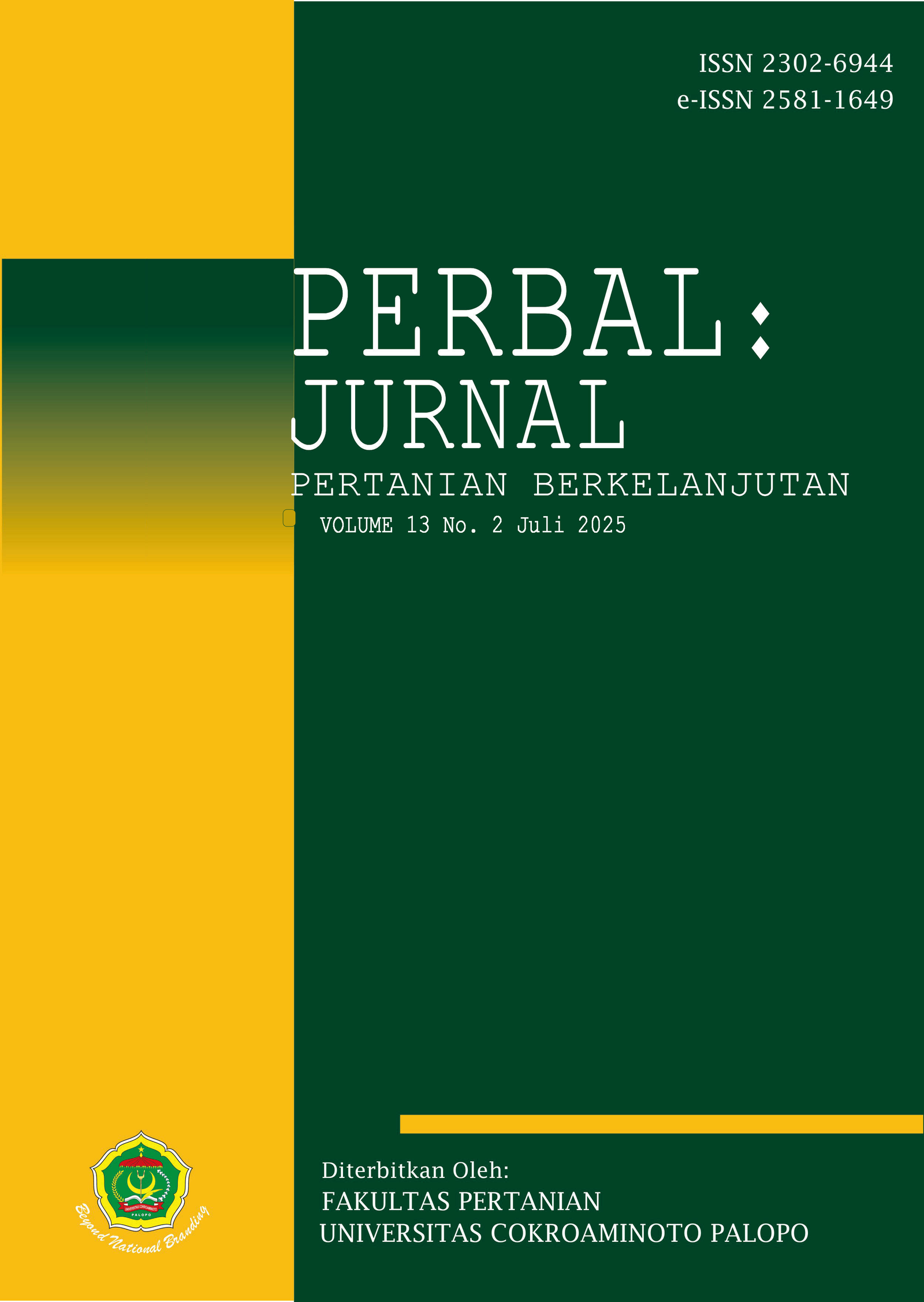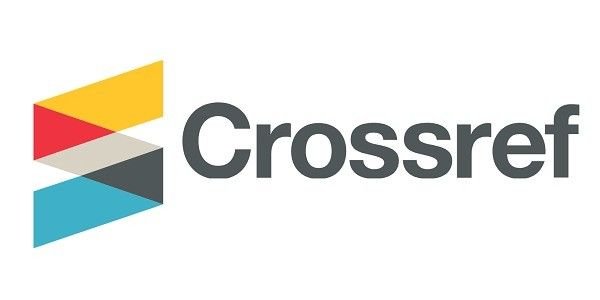Strategi Optimalisasi Pupuk NPK 16-16-16 untuk Meningkatkan Produksi Benih Tiga Varietas Alpukat dengan Teknik Sambung Pucuk
Strategy of Optimization of NPK Fertilizer 16-16-16 to Improve Seed Production of Three Avocado Varieties Using the Grafting Technique
DOI:
https://doi.org/10.30605/perbal.v13i2.5910Keywords:
Benih alpukat, Kendil, Mega gagauan, Miki, optimalisasi NPK, sambung pucukAbstract
Pemupukan pada benih alpukat di Kabupaten Kulon Progo belum memperhatikan kebutuhan dari setiap varietas yang digunakan. Penelitian ini bertujuan untuk mengetahui dosis pupuk yang sesuai kebutuhan pada beberapa varietas alpukat yakni varietas Miki, Kendil dan Mega Gagauan sehingga diharapkan mampu meningkatkan produksi benih alpukat. Metode penelitian menggunakan Rancangan Acak Kelompok Faktorial (RAKF) dengan 2 faktor yaitu varietas alpukat yang terdiri dari 3 taraf (VA1=Miki, VA2=Kendil dan VA3=Mega gaguan) dan dosis pupuk NPK 16:16:16 yang terdiri dari 5 taraf (DP0=0 g/tanaman, DP1= 1 g/tanaman, DP2= 2 g/tanaman, DP3= 3 g/tanaman, DP4=4 g/tanaman) yang diulang sebanyak 3 kali, sehingga total terdapat 45 unit percobaan. Hasil penelitian menunjukkan bahwa penggunaan pupuk NPK secara optimal dapat meningkatkan pertumbuhan diameter batang pada kombinasi perlakuan VA1DP0 (Miki+NPK 0 g/tanaman), VA2DP0 (Kendil+NPK 0 g/tanaman), dan VA3DP2 (Mega Gaguan+NPK 2 g/tanaman). Kemudian, tinggi batang atas dan jumlah daun pada kombinasi perlakuan V1DP2 (Miki+NPK 2 g/tanaman), V3DP3 (Mega Gaguan+NPK 3 g/tanaman), dan V2DP0 (Kendil+ NPK 0 g/tanaman). Selanjutnya, volume akar dan panjang akar pada kombinasi perlakuan VA1DP0 (Miki+NPK 0 g/tanaman), VA2DP3 (Kendil+NPK 3 g/tanaman), dan VA3DP3 (Mega Gaguan+NPK 3 g/tanaman).
The fertilization of avocado seedlings in Kulon Progo has not yet taken into account the specific needs of each variety used. This study aims to determine the optimal fertilizer dosage for several avocado varieties, namely Miki, Kendil, and Mega Gagauan, with the expectation of enhancing avocado seedling production. The research method employed a Factorial Randomized Block Design (FRBD) with two factors: avocado varieties consisting of three levels (VA1 = Miki, VA2 = Kendil, and VA3 = Mega Gagauan) and NPK fertilizer doses of 16:16:16 consisting of five levels (DP0 = 0 g/plant, DP1 = 1 g/plant, DP2 = 2 g/plant, DP3 = 3 g/ plant, DP4 = 4 g/plant), repeated three times, resulting in a total of 45 experimental units. The results indicate that the optimal use of NPK fertilizer can enhance the growth of stem diameter in the combinations of treatments VA1DP0 (Miki+NPK 0 g/plant), VA2DP0 (Kendil+NPK 0 g/plant), and VA3DP2 (Mega Gagauan+NPK 2 g/plant). Furthermore, the height of the upper stem and the number of leaves were improved in the combinations of treatments V1DP2 (Miki+NPK 2 g/plant), V3DP3 (Mega Gagauan+NPK 3 g/plant), and V2DP0 (Kendil+NPK 0 g/ plant). Additionally, root volume and root length were positively affected by the combinations of treatments VA1DP0 (Miki+NPK 0 g/plant), VA2DP3 (Kendil+NPK 3 g/plant), and VA3DP3 (Mega Gagauan+NPK 3 g/plant).
Downloads
References
Anisa, Z.M., & Ananto. (2021). Penggunaan pupuk majemuk (NPK) pada sambung pucuk tanaman alpukat (Persea Americana Mill). UNES Journal of Scientech Research, 6(2), 162–69.
Badan Pusat Statistik. (2021). Statistik Pertanian Hortikultura Produksi Buah-Buahan Menurut Jenis Tanaman Menurut Kabupaten/Kota Di Provinsi D.I Yogyakarta, 2021. D.I. Yogyakarta. https://www.bps.go.id/indikator/indikator/view_data_pub/0000/api_pub/SGJsZ0s5RjRyTWN1eDNyUERzbTI0Zz09/da_05/1.
Badan Pusat Statistik. (2023a). Kabupaten Kulon Progo Dalam Angka 2023. In Kulon Progo: BPS Kabupaten Kulon Progo.
Badan Pusat Statistik. (2023b). Statistik Pertanian Hortikultura Produksi Buah-Buahan Menurut Jenis Tanaman Menurut Kabupaten/Kota Di Provinsi DI Yogyakarta, 2022. D.I. Yogyakarta. https://www.bps.go.id/id/statistics-table/3/U0dKc1owczVSalJ5VFdOMWVETnlVRVJ6YlRJMFp6MDkjMw==/produksi-buah-buahan-menurut-jenis-tanaman-menurut-provinsi--2021.html?year=2022.
Badan Pusat Statistik. (2024). Statistik Pertanian Hortikultura Produksi Tanaman Buah-Buahan 2021-2023. Jakarta: Badan Pusat Statistik Indonesia.
Dalimunthe, A., Hartini, K.S., & Tampubolon, G.I. (2021). Peningkatan pertumbuhan semai alpukat (Persea Americana) dengan aplikasi berbagai dosis pupuk kandang ayam dan interval penyiraman. Prosiding Seminar Nasional Silvikultur ke VIII, 78–86.
Dastama, R., Sahputra,H., & Harahap, E.J. (2022). Pengaruh panjang entres terhadap keberhasilan sambung pucuk pada tanaman alpukat (Persea Americana Mill.)’. Jurnal Agroteknologi dan Perkebunan, 4(1), 20–29. DOI: https://doi.org/10.36490/agri.v5i1.223
Data Online BMKG. (2025). Data Online BMKG. BMKG. Dataonline. https://dataonline.bmkg.go.id/.
Dewi, S., Hayati, E., & Kesumawati, E. (2022). Pertumbuhan bibit alpukat (Persea Americana Mill) hasil sambung pucuk akibat jenis media tanam dan dosis pupuk NPK Phonska. Jurnal Floratek, 17(1), 36–46. DOI: https://doi.org/10.35138/orchidagro.v1i2.323
Eviati, Sulaeman, Herawaty, L., Anggria, L., Usman, Tantika, H.E., Prihatini, R., & Wuningrum, P. (2023). Analisis Kimia Tanah, Tanaman Air, dan Pupuk. In Petunjuk Teknis, eds. Ibrahim Adamy Sipahutar et al,. Bogor: Kementerian Pertanian RI, 1–266. https://tanahpupuk.bsip.pertanian.go.id.
Gopalasundaram, P., Bhaskaran, A., & Rakkiyappan, P. (2011). Integrated nutrient management in sugarcane. Sugar Tech, 14. doi:10.1007/s12355-011-0097-x. DOI: https://doi.org/10.1007/s12355-011-0097-x
Havlin, J.L., Tisdale, S.L., Nelson, W.L., Beaton, J.D. (2017). Soil Fertility and Fertilizers An Introduction to Nutrient Management. In Uttar Pradesh: Pearson India Education Services, 1–506. doi:10.1002/9781119403647.ch8. DOI: https://doi.org/10.1002/9781119403647.ch8
Hazra, F., & Santosa, D.A. (2022). Evaluasi pupuk hayati dan NPK terhadap pertumbuhan tanaman alpukat (Persea Americana Mill.) di Kebun Superavo, Subang. Jurnal Ilmu Tanah dan Lingkungan, 24(1), 14–19. DOI: https://doi.org/10.29244/jitl.24.1.14-19
Indradewi, R., Suhaeni, & Sacita, A.S. (2024). Identifikasi keberadaan patogen Phytophtora Sp. menjadi langkah awal seleksi pohon alpukat sebagai sumber entris di Desa Cakaruddu Sulawesi Selatan. Jurnal Pertanian Berkelanjutan, 12(1), 87–94. DOI: https://doi.org/10.30605/perbal.v12i1.3176
Indrajati, S.B., Rosita, D., & Saputra, L.D. (2021). Buku Lapang Budidaya Alpukat. ed. Direktorat Buah dan Florikultura. Jakarta: Direktorat Jenderal Hortikultura.
Irawan, U.S., Arbainsyah, Ramlan, A., Putranto, H., & Afifudin, S. (2020).. Buku Manual Persemaian Dan Pembibitan Tanaman Hutan. Operasi Wallacea Terpadu https://elti.yale.edu/sites/default/files/rsource_files/buku_ manual_persemaian_dan_pembibitan_tanaman_hutan.
Juniarrafiq, M.D. (2022). Pengaruh Model Sambungan dan Umur Batang Bawah Terhadap Keberhasilan Sambung Pucuk pada Tanaman Alpukat Mentega Pusako (Persea Americana Mill)’. Universitas Medan Area.
Kusumawati, A. (2021). Buku Ajar Kesuburan Tanah & Pemupukan. In Poltek LPP Press, ed. Rom Ubaidillah. Yogyakarta: Poltek LPP Press, 1–62.
Leghari, S.J., Wahocho, N.A, Laghari, G.M., & Laghari, A.H. (2016). Role of nitrogen for plant growth and development: a review. Advances in Environmental Biology, 10(9), 209–218. https://www.researchgate.net/publication/309704090_ Role_of_Nitrogen_for_Plant_Growth_and_Development_A_review.
Menteri Pertanian. (2019). Kepmentan RI No 42 Tahun 2019 Tentang Teknis Sertifikasi Benih Hortikultura’. : 3.
Mozumder, S.N., Moniruzzaman, M., & Halim, G. (2012). Effect of N, K and S on the yield and storability of transplanted onion (Allium cepa L.) in the Hilly Region. Journal of Agriculture & Rural Development, 5(1–2), 58–63. doi:10.3329/jard.v5i1.1459. DOI: https://doi.org/10.3329/jard.v5i1.1459
Presiden Republik Indonesia. (2019). Undang-Undang RI UU RI No 22 Tahun 2019 Sistem Budidaya Pertanian Berkelanjutan.
Purba, T., Situmeang, R., Rohman, H.F & Mahyati. (2021). Pemupukan dan Teknologi Pemupukan. In Yayasan Kita Menulis, ed. Ronal Watrianthos. Medan: Yayasan Kita Menulis, 1–150.
Rondon, T., Guzmán-Hernández, M., Torres-Madronero, M. C., Casamitjana, M., Cano, L., Galeano, J., & Goez, M. (2024). Comparative analysis of water stress regimes in avocado plants during the early development stage. Plants, 13(18), 1–17. doi:10.3390/plants13182660. DOI: https://doi.org/10.3390/plants13182660
Sadwiyanti, L., Sudasro, D., & Budiyanti, T. (2009). Petunjuk Teknis Budidaya Alpukat. 1st ed. Solok: Balai Penelitian Tanaman Buah Tropika.
Tampinongkol, C. L., Tamod, Z., & Sumayku, B. (2021). Ketersediaan unsur hara sebagai indikator pertumbuhan tanaman mentimun (Cucumis Sativus L.). Jurnal Transdisiplin Pertanian (Budidaya Tanaman, Perkebunan, Kehutanan, Peternakan, Perikanan), Sosial dan Ekonomi, 17(2), 711–18.
Velez, A.T., & Osorio, N.W. (2017). Co-inoculation with an arbuscular mycorrhizal fungus and a phosphate-solubilizing fungus promotes the plant growth and phosphate uptake of avocado plantlets in a nursery. Botany, 95(5), 539–45. doi:10.1139/cjb-2016-0224. DOI: https://doi.org/10.1139/cjb-2016-0224
Downloads
Published
Issue
Section
License
Copyright (c) 2025 Yasinta Rohmawati, Nicky Oktav Fauziah, Agus Wartapa

This work is licensed under a Creative Commons Attribution 4.0 International License.
In submitting the manuscript to the journal, the authors certify that:
- They are authorized by their co-authors to enter into these arrangements.
- The work described has not been formally published before, except in the form of an abstract or as part of a published lecture, review, thesis, or overlay journal.
- That it is not under consideration for publication elsewhere,
- That its publication has been approved by all the author(s) and by the responsible authorities – tacitly or explicitly – of the institutes where the work has been carried out.
- They secure the right to reproduce any material that has already been published or copyrighted elsewhere.
- They agree to the following license and copyright agreement.
License and Copyright Agreement
Authors who publish with Onoma Journal: Education, Languages??, and Literature agree to the following terms:
- Authors retain copyright and grant the journal right of first publication with the work simultaneously licensed under Creative Commons Attribution License (CC BY 4.0) that allows others to share the work with an acknowledgment of the work's authorship and initial publication in this journal.
- Authors are able to enter into separate, additional contractual arrangements for the non-exclusive distribution of the journal's published version of the work (e.g., post it to an institutional repository or publish it in a book), with an acknowledgment of its initial publication in this journal.
- Authors are permitted and encouraged to post their work online (e.g., in institutional repositories or on their website) prior to and during the submission process, as it can lead to productive exchanges, as well as earlier and greater citation of published work.














